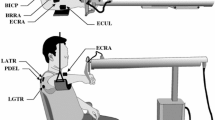Abstract
This study investigates the ability to maintain a stable position of the hand when confronted with environmental instability. Subjects were required to hold the hand inside a 0.4-mm square while counteracting the destabilizing effect of a force field, which pushed the hand away from a line in the horizontal plane. The endpoint stiffness of the relaxed arm proved to be a reliable predictor of stability. Subjects were most successful in stabilizing hand position when the direction of the force field was aligned with the direction of greatest endpoint stiffness. They were least successful when the force field was aligned in the orthogonal direction, the direction of least endpoint stiffness. Subjects increased their endpoint stiffness as the strength of the force field was increased, but when the force field was in the direction of least stiffness they eventually failed in stabilizing the hand at the highest force field strength. In contrast, they were as successful in stabilizing the hand at the highest force field strength as at the lowest, when the force field was aligned with the direction of greatest stiffness. With the elbow flexed, endpoint stiffness of the relaxed arm becomes more uniform than with the elbow extended. This was reflected in subjects’ performance, which improved considerably compared to the extended elbow posture, as force field strength was increased in the direction of lesser stiffness. The results indicate that posture was more effective than joint stiffness in stabilizing hand position.
Similar content being viewed by others
Author information
Authors and Affiliations
Corresponding author
Rights and permissions
About this article
Cite this article
Milner, T.E. Contribution of geometry and joint stiffness to mechanical stability of the human arm. Exp Brain Res 143, 515–519 (2002). https://doi.org/10.1007/s00221-002-1049-1
Received:
Accepted:
Published:
Issue Date:
DOI: https://doi.org/10.1007/s00221-002-1049-1




